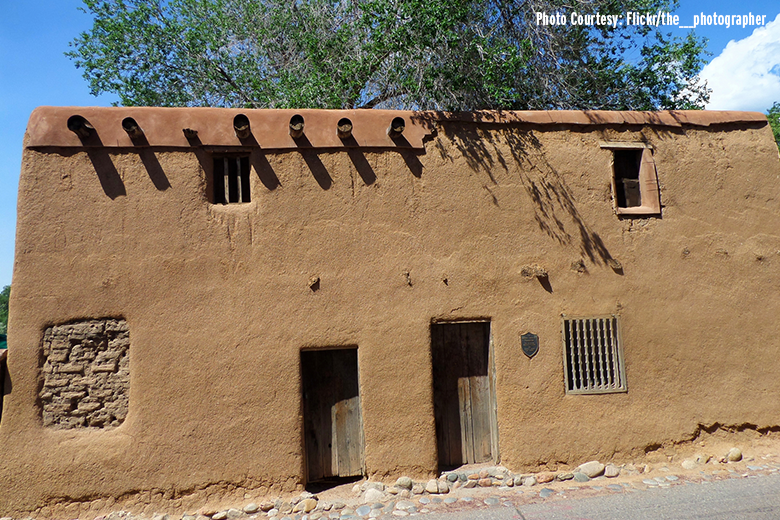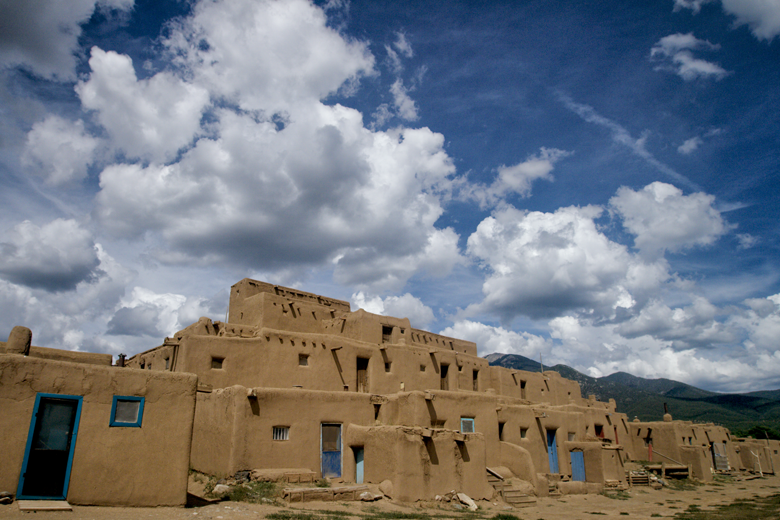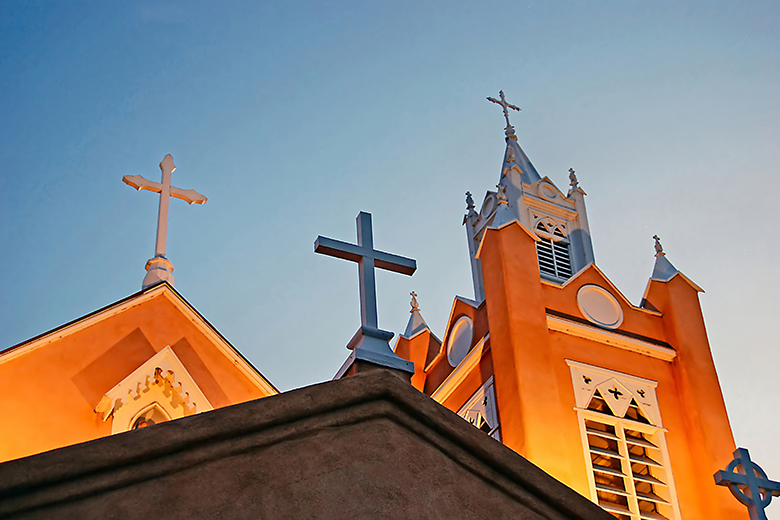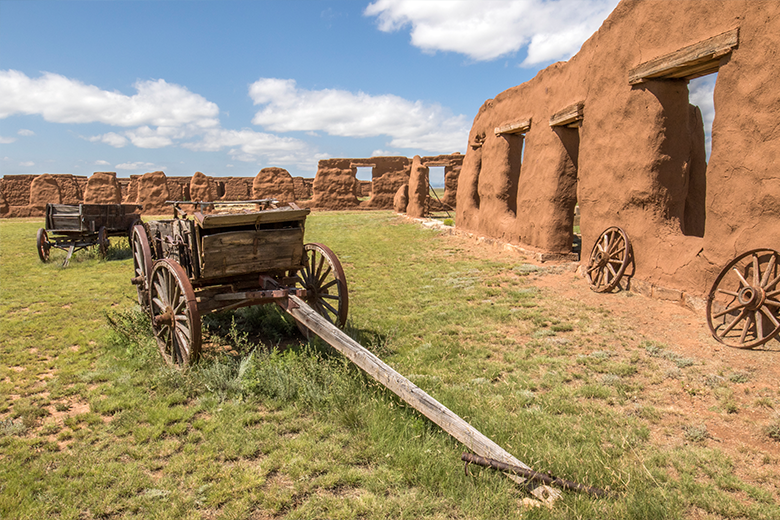
1. San Francisco De Asis Mission Church; Ranchos De Taos
Located a few miles south of the Taos Pueblo in Ranchos De Taos is the majestic San Francisco De Asis. Though sources differ, most cite this structure’s origination as somewhere between the late 1700s and early 1800s. Its beauty has inspired artists for centuries. In fact, Georgia O’Keeffe, Ansel Adams and Paul Strand, among many others, made the sanctuary famous. If you are visiting during the spring try to coordinate with the “enjarre," or re-mud. During this annual ritual the community gathers to help preserve their church by mudding a new layer of adobe on the walls with a mixture of mud and straw.
For more historic New Mexico True cathedrals, click here.

2. El Santuario de Chimayo; Chimayo
Nestled in the village of Chimayo along the High Road to Taos sits a national historic landmark, El Santuario de Chimayo. The sanctuary is known for the unusual legend of its creation and as a present-day pilgrimage site. It receives almost 300,000 visitors per year and has been called "no doubt the most important Catholic pilgrimage center in the United States.” It is also often called the “Lourdes of America” for its magical healing soil. In the small prayer room next to the sanctuary is a round hole filled with this soil. In fact, many come to the church in pursuit of this soil, hoping to find a cure for their afflictions.

3. The Oldest House; Santa Fe
Sitting in the National Historic Landmark Barrio de Analco Historic District in Santa Fe, New Mexico is The Oldest House. Located at 215 E. De Vargas Street, it is thought to be the oldest house of European origin in the United States. The exact date of construction remains unknown, though tree-ring samples suggest it was built in the mid 18th century. Now, you can discover the treasure trove of historic places in Santa Fe with a self-guided walking tour.

4. Taos Pueblo; Taos
Taos Pueblo, also known as the place of the red willows, sits at the base of the Sangre de Cristo Mountains. The village, which is one of the oldest continuously inhabited communities in North America, was designated a World Heritage Site and a National Historic Site in 1992. The adobe, multi-storied homes of Taos Pueblo helped inspire the Pueblo Revival style of architecture in contemporary New Mexico.

5. Palace of the Governors; Santa Fe
Located on the historic Santa Fe Plaza, this historic adobe served as the seat of Spanish colonial government for centuries. Originally constructed in the early 17th century, this building is now home to the New Mexico History Museum. The building was named a Registered National Historic Landmark in 1960, and an American Treasure by the National Trust for Historic Preservation in 1999.

6. Kit Carson Home; Taos
Just a block east of the iconic Taos Plaza sits the Kit Carson Home and Museum. Built in 1825, this adobe building was home to Carson’s wife and seven of their children. Inside, visitors will find an horno (adobe baking oven), drying rack and other artifacts true to the mid 19th century, photos of the Carson family and other historical figures, Carson’s U.S. Army sabre and scabbard, his Masonic hat and a replica of his .50 caliber Hawkins rifle. Take a short walk to Kit Carson Park, home to the annual Taos Solar Music Festival, to view the final resting place of this American frontiersman.

7. Old San Miguel Mission; Socorro
One of the most iconic and memorable structures in Socorro is the old San Miguel Mission at 403 El Camino Real. The church has a long, rich history, dating back to 1598 when Juan de Oñate led 400 colonists north from Mexico. A small church was built on the present site in 1626 when the Church formally recognized the mission. The church was abandoned following the Pueblo Revolt of 1680 and fell into ruins. By the early 1800s settlers had returned to the area and rebuilt the church. The church building has undergone changes over the years, including the addition of stained glass windows, a side chapel, and a new façade and towers. The main sanctuary only recently reopened after undergoing needed repairs.

8. The Mission San Esteban del Rey; Acoma Pueblo
Founded by Franciscan monks in 1629, this National Historic Landmark sits atop the Acoma Pueblo mesa. The roof is supported by large vigas, some over 40 feet long and 14 inches square, carried from the San Mateo Mountains, almost 30 miles away. Centuries of re-mudding has resulted in the adobe walls of the church being more than seven feet thick in places.

9. Double Eagle Restaurant; Old Mesilla
An anchor of the Mesilla Plaza, this 1840s adobe has a very colorful history. The area has been site to the signing of the Treaty of Guadalupe Hidalgo, the Confirmation of the Gadsden Purchase, and the imprisonment and trial of Billy the Kid in 1881. Many also believe they have seen the friendly spirits of Armando and Inez, ethereal young lovers said to inhabit the building.
The Double Eagle has also been included as one of the founding members on our Culinary Treasures Trail, which celebrates restaurants that have stood the test of time.

10. San Felipe de Neri, Albuquerque
San Felipe de Neri Church is one of the oldest surviving buildings in the city of Albuquerque. The existing church was built in 1793, though the original structure was built in 1706. It is located on the north side of Old Town Plaza in the heart of the city.
For an immersive, ABQ True experience, be sure to check out ABQ Trolley Co.’s Best of Albuquerque City Tour.

11. Christ in the Desert Monastery; Abiquiu
The Monastery of Christ in the Desert was founded in 1964 and is situated in a beautiful canyon in northwestern New Mexico, surrounded by miles of government-protected wilderness. The monks of this monastery are part of the 1,500-year tradition of Benedictine monasticism. If you are seeking endless peace and serenity, look no further.

12. San Jose de Gracia Church; Las Trampas
This church, built between 1760 and 1776, is the hallmark of Las Trampas, New Mexico. It is acclaimed as a model of the adobe architecture found throughout the state and one of the best-preserved examples of Spanish Colonial churches found in New Mexico. The church was designated a National Historic Landmark in 1970.

13. Bandelier National Monument; Los Alamos
Head into the extensive back country in north-central New Mexico to hike, camp, and explore at leisure the lands and dwellings once occupied by the ancestors of present-day Pueblo Indians. Petroglyphs, dwellings carved into the soft rock cliffs, and standing adobe walls pay tribute to the early days of a culture that still survives in the surrounding communities.

14. Puye Cliffs; Española
Once home to 1,500 Pueblo Indians, the Puye Cliffs comprises two levels of cliff and cave dwellings cut into the cliff face, as well as dwellings on the mesa top. The first level runs over a mile along the mesa base, while paths and stairways cut into the rock allow access to the second level and top of the mesa. Named a National Historic Landmark in 1966, Puye was the first of the ancient pueblos of the Rio Grande Valley to be systematically excavated.

15. Fort Union National Monument; Las Vegas
The largest military fort in the region for much of the 19th century, the territorial-style adobe of Fort Union was a key landmark for travelers along the Old Santa Fe Trail. Witness to countless expeditions, Indian raids and commercial gatherings, Fort Union today serves as a living history reminder of days of yesteryear. A 1.25-mile, self-guided interpretive trail enables visitors to tour the ruins, with a shorter 0.5-mile self guided tour for the less ambitious.
